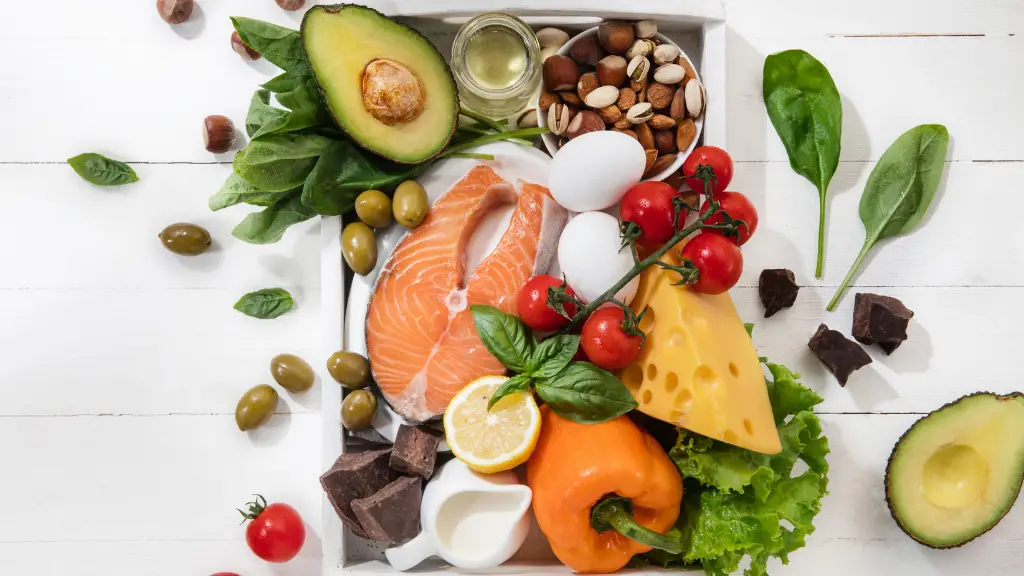A Complete Guide To Macronutrients: Definition, Functions & Examples

You are what you eat! Reiterating this fact, let’s grab some knowledge on macronutrients today.
You must be aware of the term “macronutrients.” It pops up frequently when discussing ‘eating healthy’ or ‘tips for losing weight.’
You may have seen the term “macro” discussed in the context of calculating or tracking macronutrients, but what exactly are they?
The term “macros” refers to macronutrients. As macro signifies large, your body requires more of these nutrients to function effectively. All of these nutrients provide energy to your body in the form of calories or kcals.
Carbohydrates, proteins, and fats are the 3 macronutrients.
What are macronutrients?
Macronutrients are nutritional components that your body requires in large amounts to maintain its systems and structures, unlike micronutrients, which are essential but required in smaller amounts.
You should not eliminate or severely restrict any of the three macronutrients because they are all necessary for a balanced diet.
Each macronutrient: carbohydrate, protein, and fat, has its own set of qualities that influence health, but they all provide energy. The optimal balance of their contribution to the diet has long been the subject of debate [1].
Over the last half-century, there has been a shift in understanding how each may contribute to energy balance.
Energy values of each macronutrient:
We have provided a macronutrient list with the prescribed energy values for each [2].
| Macronutrients | Energy value |
| Carbohydrates | 4 Calories/gram |
| Proteins | 4 Calories/gram |
| Fats | 9 Calories/gram |
Let’s start with discussing the types of macronutrients today, beginning with carbohydrates.
Understanding Carbohydrates :
Carbohydrates are your body’s principal fuel source. Carbohydrates should account for 45 to 65 percent of your daily calorie intake [3]. Carbohydrates are present in healthy and also unhealthy foods.
Carbs are broken down into glucose by your digestive system. Glucose is absorbed by your bloodstream and used as energy to fuel your body.
Blood sugar is affected by the number of carbohydrates you consume. Blood sugar levels can be elevated by eating a lot of carbohydrates. Hyperglycemia (high blood sugar) puts you at risk for diabetes. Low blood sugar (hypoglycemia) is a concern for some people who don’t eat enough carbohydrates.
There are two types of carbohydrates: Simple and Complex carbohydrates.
Simple Carbohydrates:
Simple carbs are present in refined and processed sugars such as confectionery, table sugar, syrups, and soft drinks.
They can be found in foods like fruits, milk, and milk products too. Simple carbs are readily broken down by the body and used as energy [4].
Simple carbs that should be avoided are found in processed foods or foods containing sugar which are nothing but empty calories. Sugar boosts the calorie level of food while providing no additional benefits.
Complex Carbohydrates:
Complex carbohydrates present in whole foods tend to be fairly wholesome.
Whole-grain foods, for example, have a coating of bran and germ that provides fiber, vitamin B and E, polyphenols, and healthy fats.
They may also lower the risk of several chronic health disorders, including type 2 diabetes, cardiovascular disease, and some types of cancer [5].
Simple Carbs. v/s Complex Carbs :
Technically speaking, simple carbohydrates are naturally found in fruits and milk, but most of them are consumed through processed foods. Complex carbohydrates include more nutrients than simple carbohydrates.
They contain more fiber and digest relatively slower. They are more fulfilling and a smarter alternative that you can consider for weight loss.
In addition to providing fuel to the body, complex carbohydrates (especially fiber) help the body maintain healthy digestive function and cholesterol levels.
The table below has a list of a few commonly used simple and complex carbs in the diet:
| Simple Carbs | Complex Carbs |
| Milk | Whole grains |
| Sweet tea | Rice |
| Table sugar | Beans |
| Fruit juice concentrate | Potatoes |
| Soft drinks | Bread |
Simple carbs to avoid:
1. Baked products:
Instead of baked products loaded with simple carbs and added sugars, satisfy your sweet craving with fruit.
2. Sweet soda:
Sugary soda is bad for health in a multitude of ways. You could perhaps try lemon-flavored water instead.
3. Fruit juice concentrates:
Examining nutrition labels is an easy method to avoid fruit concentrate. Always go for 100% fruit juice without added sugars or prepare your own at home.
4. Cookies:
Bake your own cookies with applesauce or sweeteners as alternatives, or hunt for different cookie mixes with more complex carbs.
Complex carbs as an essential part of your daily diet:
1. Fiber-rich vegetables:
Consume more vegetables, such as broccoli, leafy greens, and carrots, as they are rich in fiber [6].
2. Fiber-rich fruits:
Apples, kiwis, and bananas are a few examples. Avoid canned fruit since it often has additional syrup [6].
3. Whole grains:
Whole grains contain fiber as well as potassium, magnesium, and selenium. Choose whole grains that are less processed, like quinoa, buckwheat, and whole-wheat pasta [6].
Understanding Protein:
Protein helps your body develop, maintain, and repair tissues while also protecting lean body mass (muscle mass). Proteins are made up of amino acids, which are the building blocks of the protein chain [7].
Amino acids are classified into two types: non-essential and essential. Your diet need not consume non-essential amino acids since your body can produce them; however, it should consist of essential amino acids [7].
Animal protein v/s Plant protein:
Since your body can not store protein, you must consume enough of it each day. Protein can be obtained from a variety of food sources, including plants and animals.
Some argue that the source of protein, whether animal or plant, shouldn’t matter. Others believe that plant protein outperforms animal protein.
Let’s compare the two and know the benefits of each:
Animal protein is considered as complete protein:
Your body craves all of the necessary amino acids in the correct ratios for better health.
Meat, fish, poultry, eggs, and dairy products are high in protein, similar to the protein found in your body [8].
The nutritive value of dietary proteins is based on the bioavailability of amino acids. These are called complete protein sources because they contain all of the essential amino acids that your body requires to function properly.
Plant protein sources, on the other hand, such as beans, lentils, and nuts, are considered incomplete since they lack one or more of the key amino acids that your body requires [8].
Some nutrients are abundant in animal protein than plants:
Proteins are rarely found in isolation. They are generally accompanied by a wide range of other nutrients.
Foods containing animal protein are high in numerous nutrients that are frequently missing in plant foods.
These are some examples:
- Vitamin B12- fish, meat, and poultry. People who avoid these are deficient [9]
- Vitamin D- oily fish, eggs, and dairy. Though plants contain it, the type found in animals is better used by the body [10]
- DHA- fatty fish. It is important for the brain and is not easily available through plant sources [11]
- Zinc- beef, pork, and lamb. It is easily absorbed and used from animal sources rather than plants [12].
Diets with good amounts of plant proteins are beneficial :
Plant-protein-rich diets, such as vegetarian or vegan diets, have been related to numerous health benefits. According to studies, vegans have lower body weight, reduced cholesterol, and lower blood pressure levels.
Compared to non-vegetarians, they are also less likely to have a stroke, cancer, or die from heart diseases [13].
Understanding Fats:
Fat is a vital part of your diet, but understanding how much to consume can be tricky. Based on health-care guidance, many people have switched from a moderate-fat to a low-fat diet over the last few years.
As fats can enhance the flavor of foods, eating modest amounts of fat might make them more delightful and satisfy your hunger for longer.
To fulfill your daily requirements, you must eat a diverse diet throughout the day, including foods with low dietary fat and notably monounsaturated and polyunsaturated fats [14].
Trans fat, saturated fat, and unsaturated fat are the three categorizations of fat.
Trans fat:
Trans fats behave identically to saturated fats in the body, raising blood LDL cholesterol levels and increasing the risk of cardiovascular disease.
Unlike saturated fats, they tend to reduce HDL (good) cholesterol, making them potentially much more harmful.
Trans fats are quite rare in nature, occurring only in the stomach of cows and sheep. As a result, trans fats are naturally present in trace levels in milk, cheese, beef, and lamb [14].
| Keevs Tip: Strike out the extra fat on meat before cooking rather than removing it after. |
Saturated fat:
These fats are typically found in many discretionary foods and beverages (those that should only be consumed occasionally), such as fast foods and several commercial food products (biscuits and pastries).
Saturated fats can also be found in certain popular, nutritious food (such as dairy and meat). Unlike discretionary foods, these items contain key nutrients like protein, vitamins, and minerals that can benefit your diet [14].
| Limit the intake of saturated fats like butter. You can substitute it with olive or canola oil which is unsaturated and healthy! [14] |
Unsaturated fat:
The presence of double bonds enables the identification of unsaturated lipids. Monounsaturated fats have a single, double bond, whereas polyunsaturated fats have multiple double bonds.
One of the health benefits of monounsaturated fat is a lower risk of major chronic diseases like heart disease [15]. An example of MUFA is olive oil.
Polyunsaturated fats are marginally more effective than monounsaturated fats for lowering LDL cholesterol [14]. An example of PUFA is salmon.
Replace foods and beverages high in saturated fat with monounsaturated or polyunsaturated alternatives wherever possible.
| Nuts serve as a great snack option for unsaturated fatty foods. Grab some when falling short on energy! [14] |
Macronutrient meals:
We’ve all heard the phrase “you are what you eat.” Live on a diet rich in macronutrient foods like fruits and vegetables, whole grains, and good fats, and you will surely feel so much better.
If you eat fast food all the time, you are more likely to become unhealthy and obese [16].
Protein, which is found in meat and plant-based meals such as legumes, seeds, and grains, is the key component for developing brain cells, muscle, skin, hair, and nails.
Healthy fats are crucial for healthy body function but have been frequently underestimated (and avoided by individuals).
Hence, a diet that is packed with all the above nutrients is considered a Macronutrient meal. Consuming everything in moderate amounts is its key feature.
How to figure out your macronutrient requirements?
You may now have understood what macronutrients are and how many calories they comprise. You’ll now need to do some math.
This is because your intake ratio is given in percentages, whereas nutrition information is presented in grams. Follow the steps below to figure out your requirement.
- First, calculate your energy requirements.
- Next, determine the ratio. For example, 60% Carbs, 15% protein, and 25% fats.
- Next, simply multiply your daily calories with your percentages.
- Lastly, divide them with the energy values given in the table provided in our blog.
For instance, your daily energy requirement is 2000 kcals.
- Your carbs will be 2000 x 0.60
- Your protein will be 2000 x 0.15
- Your fats will be 2000 x 0.25 respectively.
You can then simply divide the values with the energy values in grams and get your daily requirements! But it is better to consult a dietitian as these requirements stand different for everyone.
Should you count Macronutrients instead of calories?
The topic itself is still debatable, with not one component overpowering the other.
Calorie counting was formerly one of the most popular ways to lose weight and get healthy. Counting Macronutrients, on the other hand, has risen to prominence in recent years.
Counting macros not only gives you an overview of how much carbs, lipids, and proteins you’re getting in your daily diet.
When we are overly concerned with calorie counting, we frequently overlook our nutritional requirements. We may sacrifice quality if we confine ourselves to quantity.
Tracking macros should never be an alternative to eating a well-balanced or nutrient-dense diet. Whether you’re tracking calories or macros, it’s essential to be conscious of what you’re feeding your body.
If you decide to try macro-tracking, remember to include balanced and high-quality food whenever possible.
Wrapping up :
Proper nutrition is important for our overall health and well-being. How macronutrients contribute to our diet may be influenced by the level of food processing and the ability of food systems to support future populations.
However, if you can adhere to the program and pay attention to what you eat, the advantages may surpass the effort you put in.
There is no such thing as a diet plan that is 100 percent guaranteed to work. But if you try and incorporate one, it will surely help you live a healthy life!
References:
- Carreiro, Alicia Let al. “The Macronutrients, Appetite, and Energy Intake.” Annual review of nutrition vol. 36 (2016): 73-103.
- “How many calories are in one gram of fat, carbohydrate, or protein?” U.S.Department of Agriculture (2021)
- Manore, Melinda M. “Exercise and the Institute of Medicine recommendations for nutrition.” Current sports medicine reports vol. 4,4 (2005): 193-8.
- “Simple Carbohydrates” Medline plus (2021)
- McRae, Marc P. “Health Benefits of Dietary Whole Grains: An Umbrella Review of Meta-analyses.” Journal of chiropractic medicine vol. 16,1 (2017): 10-18.
- “High-fiber foods.” Medline Plus (2021)
- “What are proteins and what do they do?” Medline Plus (2021)
- Hoffman, Jay R, and Michael J Falvo. “Protein – Which is Best?.” Journal of sports science & medicine vol. 3,3 118-30 (2004)
- Pawlak, R et al. “The prevalence of cobalamin deficiency among vegetarians assessed by serum vitamin B12: a review of literature.” European journal of clinical nutrition vol. 68,5 (2014): 541-8.
- Romagnoli, Elisabetta et al. “Short and long-term variations in serum calciotropic hormones after a single very large dose of ergocalciferol (vitamin D2) or cholecalciferol (vitamin D3) in the elderly.” The Journal of clinical endocrinology and metabolism vol. 93,8 (2008): 3015-20.
- Gebauer, Sarah K et al. “n-3 fatty acid dietary recommendations and food sources to achieve essentiality and cardiovascular benefits.” The American journal of clinical nutrition vol. 83,6 Suppl (2006): 1526S-1535S.
- Cotton, Paul A et al. “Dietary sources of nutrients among US adults, 1994 to 1996.” Journal of the American Dietetic Association vol. 104,6 (2004): 921-30.
- Craig, Winston John. “Nutrition concerns and health effects of vegetarian diets.” Nutrition in clinical practice: official publication of the American Society for Parenteral and Enteral Nutrition vol. 25,6 (2010): 613-20.
- “Dietary fat.” Better Health Channel (2020)
- Joris, Peter J, and Ronald P Mensink. “Role of cis-Monounsaturated Fatty Acids in the Prevention of Coronary Heart Disease.” Current atherosclerosis reports vol. 18,7 (2016): 38.
- Fogelholm, Mikael et al. “Dietary macronutrients and food consumption as determinants of long-term weight change in adult populations: a systematic literature review.” Food & nutrition research vol. 56 (2012): 10.3402/for.v56i0.19103.
![Blue Foods List [with pictures]](https://keevs.com/wp-content/uploads/2023/03/Blue-Foods-List-with-pictures-300x158.png)






